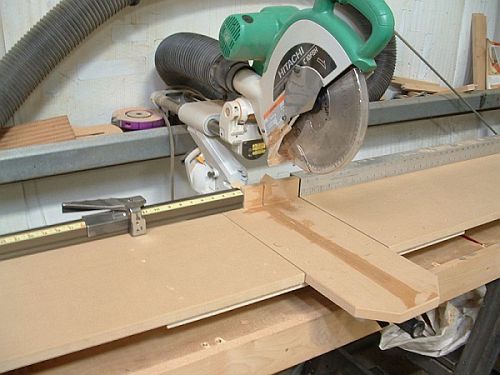Cross-Cut Setups for the Shop
Woodworkers discuss radial-arm saw and sliding miter-saw choices for cross-cutting stock in the shop. May 16, 2008
Question
I am setting up a cut off station in my small one man shop. I want to rough cut to length 8/4 hardwoods up to about 10" wide. I have been looking at 12" miter saws. As I am aging I am becoming less inclined to use my table saw for cutoff work on 8'-10' planks. I am leaving the door open for 10" sliding saws but the less is better I think in this case. I have a simple 10" miter saw I use for final compound length cuts set all the time at the compound angles. Also, what is the preferred blade for this work?
Forum Responses
(Furniture Making Forum)
From contributor A:
I have a 10" radial arm that is used for nothing but cutting rough stock to length. No precision cuts at all. I put a Forrest Chopmaster on it and it cuts very nicely. I work with rough stock 4/4 - 8/4 up to 16' long.
When I'm done with all the milling, then I cut to finished length on the tablesaw. The nice thing about this setup is you can get a secondhand radial for cheaper than a new slider. And with my radial I can cut 13" wide boards.
From contributor B:
Iíve got a 12" slider collecting dust on a shelf. For me, it's too much machine for small stuff, and sometimes I find the 12" blade flexing on thick hardwoods or in huge crown. I use a 10" Makita slider with a Forrest Chopmaster daily, and find it very good to outstanding 99% of the time. Obviously, all finicky work has to be done on a sled on the table saw, and Iíve got an old Inca for the surgical items. I keep the yellow one around for the rare occasion when itís the only thing that could possibly work.
From contributor C:
For general cut off applications like yours, you should use a radial arm saw blade. It has a negative hook angle to prevent grabbing and provides excellent crosscuts in all wood materials. It pays to buy industrial saw blades as they are made for heavy duty applications and will have little flex due to harder more tensioned plates. It is also recommended that you always use stabilizer collars to help support your saw blades. This will minimize saw deflection and provide you the best cuts possible.
From the original questioner:
Thank you to all. I had not considered a radial arm saw because of poor experience with one when I started woodworking "way back when". Also my little chair shop will need revamping for adding a bigger footprint machine.
From contributor D:
What is this "bad experience" you speak of? In my shop I use a
DeWalt 14 inch radial arm saw. It is great, and it is from 1956. They just don't make tools like they used to. I use a Hitachi 12in slider for finishing cuts and it's great also.
From the original questioner:
The bad time with a radial saw was with a 10" Rockwell of 1970's vintage. Not enough power - then bind - and get knocked out of square. I sold it and have not been a fan of them since. As my shop is now I do not have space for a really good industrial radial arm saw. If I set things up right I can have a single table with both my miter saws in a line a few feet apart. Thanks for your input.
From contributor E:
Here's how I get 15" crosscut on a 10" saw. I have a similar setup for rough stock breakdown that is a 12" slider. (I don't like the dust collection on the bigger DeWalt, but the handle is comfy.) For rough cuts, it helps to angle the rear fences back from the cut point to prevent binding. I use a thin kerf blade for rough cuts and Chopmaster for finish.

